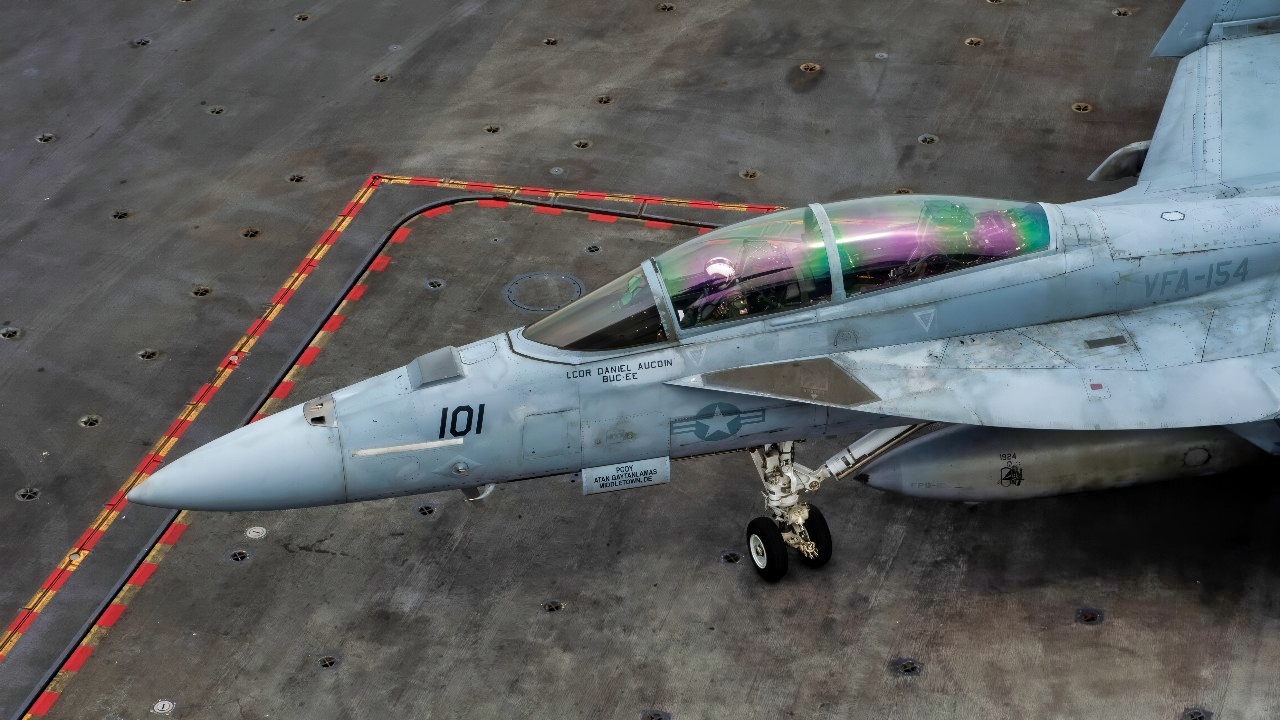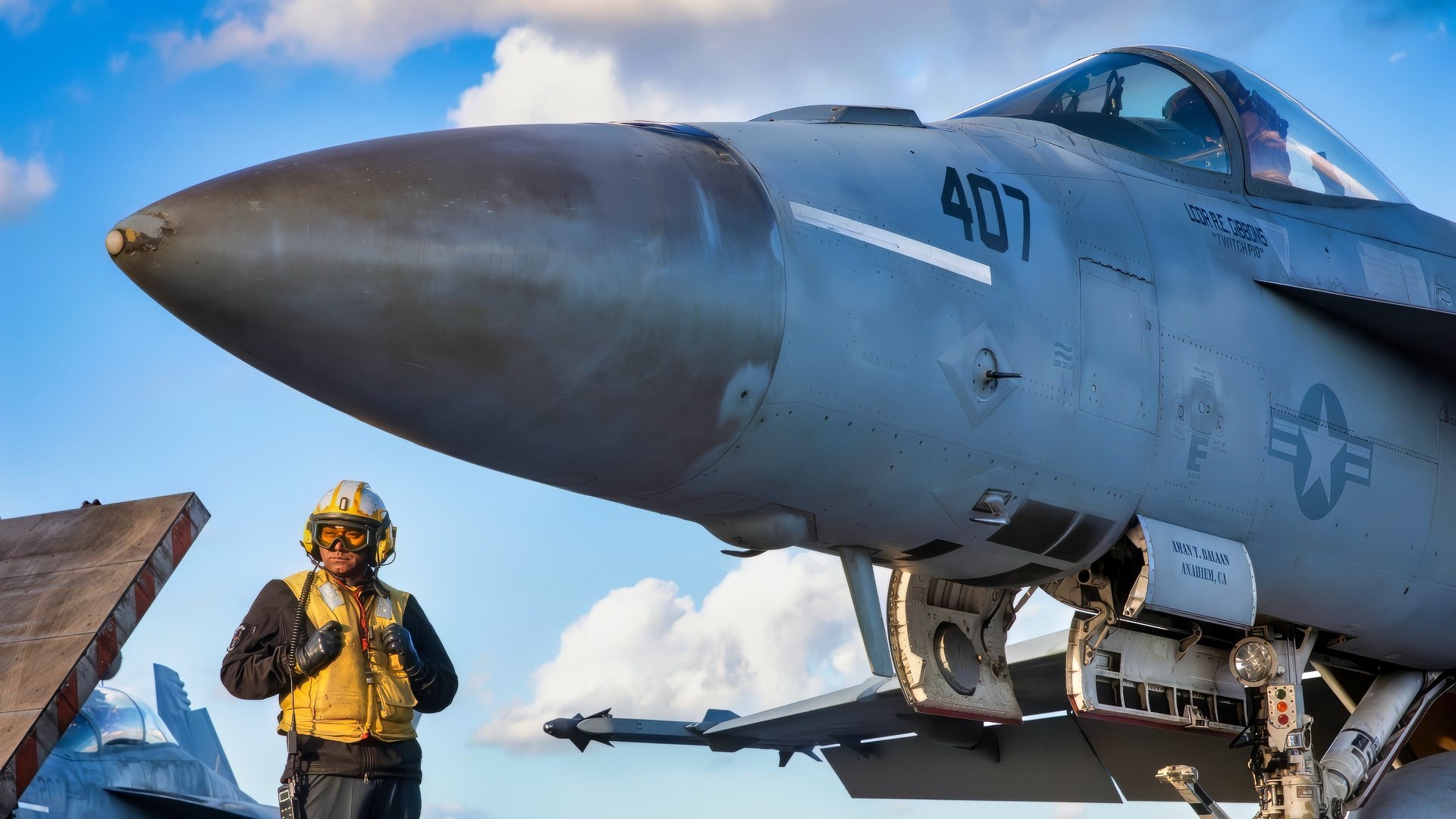Key Points and Summary – According to a former U.S. Navy pilot, the F/A-18 Super Hornet “isn’t complicated to fly” thanks to its modern systems and effective autopilot.
-However, the pilot explained that what is complicated is performing the jet’s actual combat missions.

(July 24, 2025) – A U.S. Navy F/A-18F Super Hornet, assigned to the “Black Knights” of Strike Fighter Squadron (VFA) 154, transits the flight deck of Nimitz-class aircraft carrier USS Theodore Roosevelt (CVN 71), July 24, 2025. Theodore Roosevelt, flagship of Carrier Strike Group (CSG) 9, is underway conducting exercises to bolster strike group readiness and capability in the U.S. 3rd Fleet area of operations. (U.S. Navy photo by Mass Communication Specialist Seaman Maddix Almeyda)
-The administrative parts of flying are easy, but the difficulty lies in executing its diverse roles, from air-to-air combat to electronic attack and, most significantly, the “complicated” and high-stakes challenge of landing on an aircraft carrier.
-This insight comes as the Super Hornet fleet is receiving new life-extending upgrades and advanced electronic warfare prototypes.
F/A-18 Super Hornet Fighter: Hard to Fly?
The F/A-18 Super Hornet is in the news this week, after Secretary of War Pete Hegseth recently took a ride in one.
“The Chairman and I took a ride into the danger zone with TOPGUN at Naval Air Station Fallon,” Hegseth posted to X this week, over video of himself flying in the jet along with Joint Chiefs of Staff Chairman Gen. Dan Caine.
The Pentagon also released cockpit footage of Hegseth’s flight, which, per LiveMint, featured the secretary “experiencing high-speed maneuvers and aerial rolls with TOPGUN instructor Lt. Cmdr. Dillon ‘Bodacious’ Hamrick.”
The flight was timed to coincide with the celebrations of the Navy’s 250th birthday, with the secretary’s visit described as “part of a broader effort to spotlight the Navy’s aviation excellence and recognize the service members behind its training programs.”

A Sailor directs an F/A-18E Super Hornet from the “Kestrels” of Strike Fighter Squadron (VFA) 137 on the flight deck of the aircraft carrier USS Nimitz (CVN 68) in the South China Sea, May 12, 2025. Nimitz is underway in the U.S. 7th Fleet area of operations on a scheduled deployment, demonstrating the U.S. Navy’s unwavering commitment to a free and open Indo-Pacific. (U.S. Navy Photo by Mass Communication Specialist Seaman Apprentice Franklyn M. Guage)
“Flying with these incredible pilots was an honor,” Hegseth said after the flight. “Their professionalism, precision, and patriotism are unmatched.”
According to Defence Blog, which cited the Pentagon announcement, the Navy announced plans last month to extend the Super Hornet’s service life as part of a $198 million deal that will “integrate advanced Block III avionics capabilities.”
Work will be carried out in San Diego, San Antonio, and St. Louis, with the program expected to be completed by February 2026.
Moving the Upgrade Work
In other news, Boeing announced it will transfer Super Hornet upgrade work away from its St. Louis facilities.
According to Manufacturing Dive, work will move out of the St. Louis facilities in 2026. The switch is apparently unrelated to an ongoing strike affecting those facilities that has now hit the 80-day mark.
“As part of Boeing’s [NYSE: BA] expansion and transition plans to support future programs, the company is relocating its F/A-18 Super Hornet Service Life Modification (SLM) work out of the St. Louis region and will sunset the St. Louis-based work in 2027,” Boeing announced in a press release, adding that a new site has not yet been chosen for the work. San Antonio and Jacksonville are contenders.
The St. Louis facility is scheduled to host the production of the new F-47 sixth-generation fighter.
“Our expansion plans across the St. Louis site triggered the execution of a multi-year strategic plan, requiring the relocation of some work,” said Dan Gillian, vice president and general manager of Air Dominance and senior St. Louis site executive, said in the release.

NGAD. Image Credit. Lockheed Martin.
“Given we are already successfully conducting SLM at other locations, this move is logical so we can continue to meet our customers’ commitments while ensuring we are well poised for future work,” Gillian added.
A Prototype Passes
Meanwhile, Raytheon announced in September that it had successfully “completed a major review of its new Advanced Electronic Warfare (ADVEW) prototype for the U.S. Navy’s F/A-18E/F Super Hornet.” The new prototype is expected to replace current systems such as the AN/ALQ-214 integrated defensive electronic countermeasure and AN/ALR-67(V)3 radar warning receiver.
“Our ADVEW prototype continues to showcase significant progress in both hardware and software that will improve the aircraft’s ability to detect and counter electronic threats,” Dan Theisen, president of advanced products & solutions at Raytheon, stated in the company’s release.
According to Naval Technology, more demonstrations are set to take place in the coming months.
The War Zone reported earlier this week that an infrared pod has gotten a “new vote of confidence.”
Lockheed, TWZ reported, “has received a new full-rate production contract, valued at $233 million, for Block II IRST21 infrared search and track sensors to go into pods for U.S. Navy and U.S. Air National Guard fighters.” The Navy has wanted this capability for Super Hornets since 2007, TWZ reported, but the effort has “faced hurdles.”
How to Fly the Hornet
According to an Aviation Geek Club story this week, a former F/A-18 Super Hornet named Adam Daymude recently discussed in a Quora thread how hard it is to fly the Super Hornet. The Super Hornet “isn’t complicated to fly. It’s complicated to do what it’s built for.”
“‘Flying the F/A-18 Super Hornet isn’t hard,” Daymude said in the Quora thread. “It’s a dream come true for us poor souls that came from jalopies (so much love my first steed, the EA-6B Prowler, but come on!). The autopilot isn’t quite as good as commercial, but it was good enough that after a mission, I could throw a dip in, wipe my forehead, and just lean back for a bit.”
The challenge, he made clear, was the very act of flying the plane itself.

Aviation Boatswain’s Mate (Aircraft Handling) 1st Class Jose Mejiacastro, assigned to Air Department aboard the world’s largest aircraft carrier, USS Gerald R. Ford (CVN 78), prepares to signal to a Carrier Air Wing 8 F/A-18E Super Hornet attached to Strike Fighter Squadron 87 on the flight deck, Sept. 26, 2025. Gerald R. Ford, a first-in-class aircraft carrier and deployed flagship of Carrier Strike Group Twelve, is on a scheduled deployment in the U.S. 6th Fleet area of operations to support the warfighting effectiveness, lethality and readiness of U.S. Naval Forces Europe-Africa, and defend U.S., Allied and partner interests in the region. (U.S. Navy photo by Mass Communication Specialist 2nd Class Mariano Lopez)
“What makes it complicated is all that stuff we do between taking off and landing. See, all of the admin stuff, like taking off and landing, is an assumption. You’re assumed to be able to do that,” he said. “Except if you’re Navy, like the Super Hornet, and have to practice landing at the boat. That alone should let you know why the Hornet is complicated to fly, because it’s complicated what you’re trying to do with it.”
Which isn’t to say that landing it is simple.
“But the boat aside, all that other stuff we do is complicated and complicated to explain,” Daymude said on the site. “Some guys are attacking other airplanes. Some guys are attacking air defenses. Some guys are flying close air support. H***! Some guys are hanging around the boat with extra fuel and tanks for their buddies to refuel them if they’re having a hard time getting aboard (landing at the boat).”
About the Author: Stephen Silver
Stephen Silver is an award-winning journalist, essayist, and film critic, and contributor to the Philadelphia Inquirer, the Jewish Telegraphic Agency, Broad Street Review, and Splice Today. The co-founder of the Philadelphia Film Critics Circle, Stephen lives in suburban Philadelphia with his wife and two sons. For over a decade, Stephen has authored thousands of articles that focus on politics, national security, technology, and the economy. Follow him on X (formerly Twitter) at @StephenSilver, and subscribe to his Substack newsletter.
More Military
Nimitz-Class Aircraft Carrier USS Carl Vinson Has a Message for the U.S. Navy
The Navy’s New DDG(X) Destroyer Looks Like a Missile and Laser Machine
Germany’s Big F-35 Fighter Purchase Comes Down to 1 Word
Eurofighter Typhoon vs. JAS 39 Gripen E: Who Wins Summed up in 4 Words
JAS 39 Gripen E vs. Dassault Rafale Fighter: Who Wins in a Fight Summed Up in 4 Words










